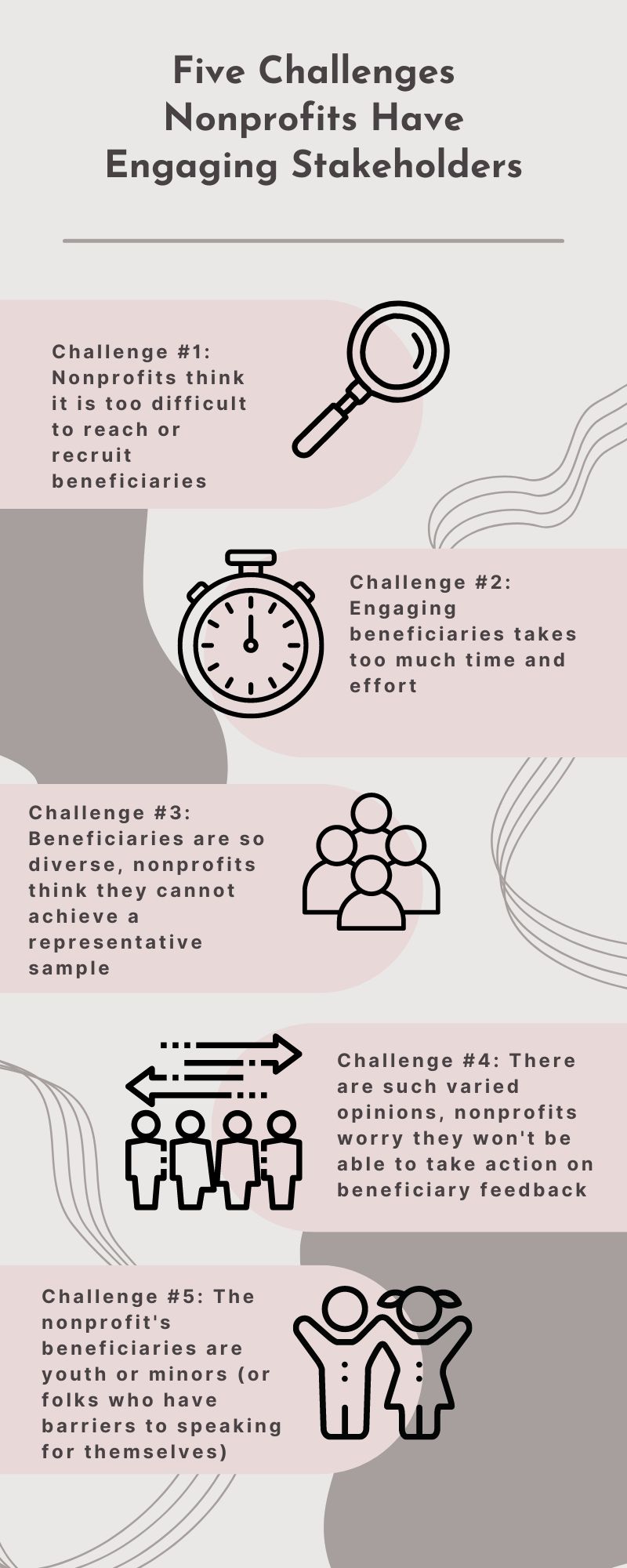You know by now that stakeholder engagement is core to our work at Prosper Strategies, and that prioritizing engaging beneficiaries is particularly central to our Shared Power StrategyTM philosophy. However, we recognize that engaging beneficiaries and stakeholders can be challenging for many organizations because it takes more time, effort and resources, not to mention, some audiences are harder to reach than others. In this post, we’ll review some of the common challenges nonprofits have with engaging beneficiaries and share some solutions for consideration.
Challenge 1: Nonprofits think it is too difficult to reach or recruit beneficiaries
Difficulty reaching or recruiting beneficiaries is most typical of an organization that doesn’t provide direct service and therefore may not directly work with beneficiaries on a daily basis. It’s also common when organizations are trying to reach new or different beneficiaries who they’ve never served before. For example, some nonprofits want to connect with individuals who don’t participate in their offerings to find out why that is.
When trying to connect to new and different, sometimes hard to reach audiences, some strategies we’ve found successful include:
- Partnering with folks who work directly with beneficiaries — like program officers, community partners or case workers — for both outreach and the engagement itself.
- Partnering with other nonprofit or community organizations to pursue stakeholder insights together. For example, if you’re a youth services organization, reach out to other youth services organizations to see if you can partner on community outreach and engagement with similar goals in mind.
- Work with a connected leader in the community, such as a faith leader, to identify those with relevant lived experience.
- Hire a stakeholder recruitment firm to conduct outreach on your behalf.
Challenge 2: Engaging beneficiaries takes too much time and effort
It is true, directly engaging beneficiaries takes additional time, effort and resources. Having seen this play out dozens of times, I can say slowing down the process to accommodate feedback (from beneficiaries and others), will reshape your organization’s strategies in ways you were not expecting and almost always for the better. As a result of stakeholder and beneficiary feedback, we’ve seen organizations embrace social and racial justice in ways they never thought possible, we’ve seen them add or do away with programs and services, we’ve seen them make modifications that preserve the dignity and respect of those they serve.
Challenge 3: Beneficiaries are so diverse, nonprofits believe they cannot achieve a representative sample
Think about the diversity of people your organization exists to serve. For many nonprofits, it can be overwhelming to think about how you engage beneficiaries and gather perspectives across various races, ethnicities, ages, genders, demographic and psychographic differences. Achieving meaningful and representative samples is absolutely a challenge. A few suggestions:
- First, think about the communities where the issue you exist to solve is most prevalent, and begin prioritizing gathering feedback from those communities. For example, if 60 percent of the people who you serve identify as Black, 30 percent identify as Latino and 10 percent identify as white, the groups you are asking for input should include a similar makeup.
- You can also design insight gathering to accommodate groups of people who are likely to have similar lived experiences, identity-based characteristics, or demographic or psychographic characteristics.
- Use multiple means of data collection that incorporate qualitative and quantitative methodologies.
- As you’re analyzing the data, be sure to weigh it appropriately. For example a focus group of 10 should be considered differently than a survey of 500. Consider a small vocal minority as one input rather than representative.
Challenge 4: There are such varied opinions, nonprofits worry they won’t be able to take action on beneficiary feedback
By the very nature of engaging beneficiaries to gather feedback, you’re going to hear varied opinions. However, it’s more than likely, you’re also going to see areas where folks strongly agree (or disagree) on particular issues. This strong agreement or disagreement can bring your nonprofit focus.
Additionally, it is common for groups with similar makeup to also bring similar perspectives. For example, you may find folks you engaged who were 60 plus have very different opinions than folks you engaged who were between the ages of 30 and 50. Segmenting feedback by audience can help you determine how to best shape your strategies for the different groups you exist to serve.
Challenge 5: The nonprofit’s beneficiaries are youth or minors (or folks who have barriers to speaking for themselves)
Engaging youth or folks who have barriers to speaking for themselves brings with it its own set of challenges. If you need to reach children or teens, you can either start with parents to gain consent or talk to the folks who work with kids each day. Another good option for gathering youth perspectives is by engaging individuals who used to participate in programs and services as children, but have now moved on and are adults. These individuals might not have the perspectives of youth currently participating, but they can reflect back and provide insights from their own time with a program or service. For those who have barriers to speaking for themselves, you can seek to engage family members, program officers or other members of the community that work directly with these individuals on a regular basis to try to gain perspectives.

Whenever engaging stakeholders, it’s important to consider the best practices for doing so, which include:
- Letting beneficiaries lead the way by asking them how they want to be engaged
- Taking a coordinated approach to beneficiary engagement across the entire organization
- Getting as close to a “representative sample” as possible
- Using trauma-informed practices
- Considering a community advisory board
- Considering compensation
- Adopting a learning mindset
What other challenges have you faced with beneficiary engagement?